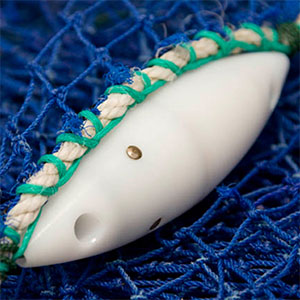|
Fish Factor Pinger rebates for AK salmon fishermen; prevent whales from getting tangled in gearBy LAINE WELCH
May 09, 2016
“Pingers can be really helpful to alert the whales to something in front of them so you have less entanglements,” said Kathy Hansen, director of the Southeast Alaska Fisheries Alliance. SEAFA received a $25,000 Hollings Grant from the National Marine Sanctuary Foundation to fund the pinger program, which offers a $25 rebate for up to five pingers per permit per vessel on units purchased after May 1. The pingers can retail for up to $100 each and the cost can deter fishermen from buying them. “A Southeast gillnet that is 200 fathoms long needs at least five,” Hansen said, adding that the rebates apply to any Alaska salmon fishery. The pinger signal in this case signal is aimed primarily at preventing entanglements of baleen whales. “Baleen whales don’t have sonar like people think all marine mammals have. They actually just hear,” Hansen said. “So the pinger emits a noise at a frequency that is not harmful and doesn’t scare the whales – it just lets them know something is there.” Baleen whales are the largest animals on earth, yet they feed on the smallest creatures in the ocean. They are named for the long plates of baleen which hang like flexible teeth of a comb from their upper jaws, which strain huge volumes of ocean water through their plates to capture tons of zooplankton, crustaceans, and small fish. The whales also have blowholes; both features distinguish them from toothed whales. Hansen said she has used pingers in her salmon driftnet gear for over six years and swears by them. “You must be sure they are not spaced too far apart or the whales think there is an opening between them,” she advised. She added that the pingers do not act like a “dinner bell” for whales, nor do they scare away the salmon. Gear encounters by whales are rare in Alaska, with 130 large whale entanglement reports on the books since 1998. According to NOAA’s Protected Resources Division. Kodiak ranks second in the U.S. for volume of fish landings and third for value. Now residents want to make sure new ways of running the fisheries sustain that status. To provide guidance, a new economic impact report breaks down how the entire seafood industry plays out throughout the Kodiak Island Borough, which includes six outlying villages for a total population of 14,000 residents. The draft report done by the McDowell Group gives a 10 year snapshot starting in 2005. Some highlights:
The study concludes that any management policies or priorities that change the volumes or values of fish harvested and processed in the Kodiak borough will have direct, indirect and induced economic effects over time. Fish Tech courses have gone mobile with iPads that allow students to start their training anywhere. The waterproof iPads are the latest tool offered by the University of Alaska/Southeast to prepare students for jobs as fish culturists, hatchery operators, field technicians and managers. “You don’t need accessibility to the internet because all the lectures, videos, readings and exams are preloaded on the IPad. So you could be out at sea and still have access to your classes,” said Ashley Burns in Kodiak, one of six UAS outreach coordinators also in Bethel, Valdez, Petersburg, Homer and Dillingham. The first iPad course is an introduction to fisheries of Alaska, and other classes will be added throughout the year. Each course earns credits toward occupational endorsements, certificates and other degrees. Jobs in Fish Tech fields are readily available due to a shortage of trained workers in Alaska, a trend expected to last for at least a decade. “Our program works heavily with the industry to make sure that our classes being offered are exactly what they are looking for in potential employees,” Burns said, adding that registration for new students is open now.
Laine Welch ©2016 Laine can be reached
at msfish[AT]alaska.com
SitNews ©2016 Stories In The News Ketchikan, Alaska
|
|||

